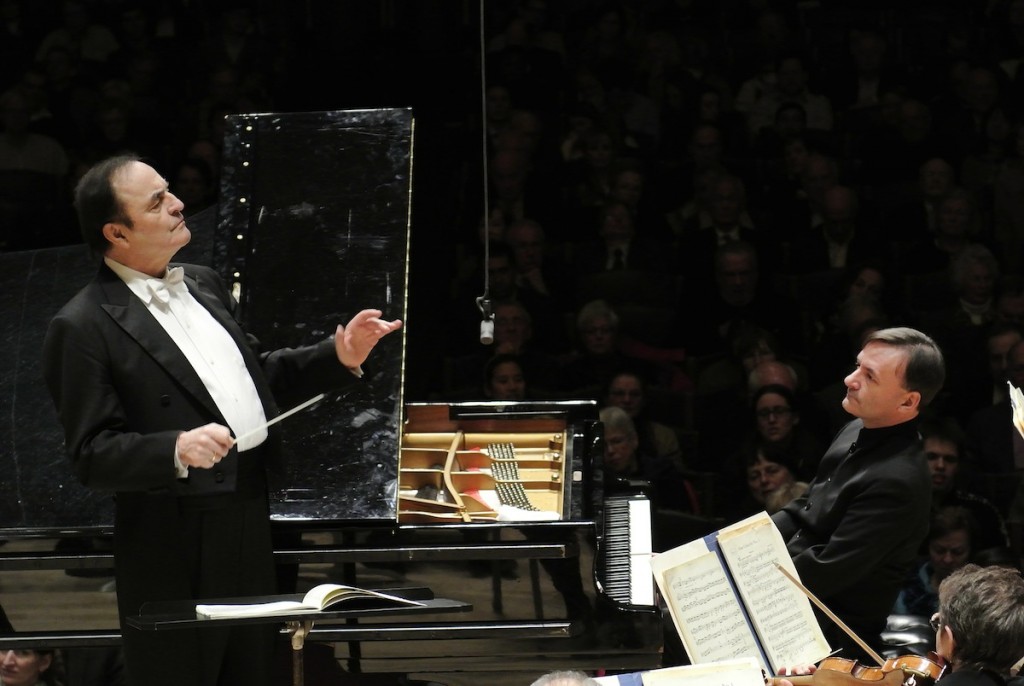Dutoit leads BSO in energetic, boldly colored Romantic program

Charles conducting the BSO with Stephen Hough as soloist in Liszt’s Piano Concerto No. 1 Thursday night at Symphony Hall. Photo: Stu Rosner
Charles Dutoit returned to Symphony Hall Thursday night to lead the BSO in a program of colorful works put across with plenty of energy.
That was certainly the case with Liszt’s Piano Concerto No. 1 in E-flat, which featured versatile English pianist Stephen Hough in the solo seat. From the famous opening statement—to which Liszt’s son-in-law Hans von Bülow allegedly set the words “Das versteht ihr alle nicht, haha!” (None of you understand this, haha!)—Hough kept a fine balance between his piano and the orchestra, performing with open but controlled phrasing and rubato.
Liszt’s economical four-movement work resembles a rhapsody more than traditional concerto forms. Here, the piano pairs frequently with solo and small groups of winds and strings, tossing and developing the themes in fiery and nuanced episodic passages.
Hough seemed intent on proving that this is a work with greater depths than the lightweight showpiece detractors claim. The soloist exhibited his strongest playing in the lyrical second movement, which is cast in the composer’s sensitive, vocalise-style writing for piano. The performance also contained plenty of fireworks, but Hough kept them under tight rein, opting instead for polish, clarity, and rounded phrasing, which may have contributed to a slightly underwhelming performance.
There was more fire at the start of the evening when Dutoit led a sparkling rendering of Hindemith’s Symphonic Metamorphosis on Themes of Carl Maria von Weber. Almost leading from behind, he conducted with a light but steady hand that gave each section of the BSO plenty of room to showcase its technical prowess in this driving, muscular work. Dutoit conducted the second-movement Scherzo, based on themes from Weber’s incidental music from his Turandot, with free-flowing character that rounded the rough edges of Hindemith’s characteristic mechanical style. The jazzy trio of the scherzo popped with fine, precise playing from the brass section.
The third movement, under Dutoit’s lead, captured some of Hindemith’s more lyrical moments, where the unusual and even grotesque beauty of the music resembles the “Grablegung” section of his Mathis der Maler. Dutoit directed the boisterous concluding march with equal parts pomp and precision.
The BSO was in prime form in the concert’s finale—musical selections drawn from the two Op. 64 suites of Prokofiev’s ballet Romeo and Juliet.
Prokofiev’s score mixes Tchaikovskian romanticism with Neoclassical edge and dissonance. The sweeping strings in the “Madrigal” movement are a stark contrast to the clamorous introduction to “Montagues and Capulets,” which opened this combination of the two suites.
In particular, the composer’s colorful orchestration highlighted several BSO principals. Flutist Elizabeth Rowe performed with agile dexterity in the “Madrigal” and principal trumpeter Thomas Rolfs played with crisp attack and warm tone in the “Minuet.” Dutoit opened the throttle for “The Death of Tybalt” and maintained that energy in the angst-ridden “Romeo at Juliet’s Tomb,” which brought a hushed conclusion to an evening of vividly played music.
The program repeats 1:30 p.m. Friday and 8 p.m. Saturday at Symphony Hall. bso.org; 617-266-1492
Posted in Performances




